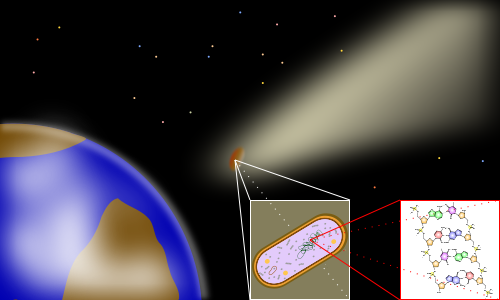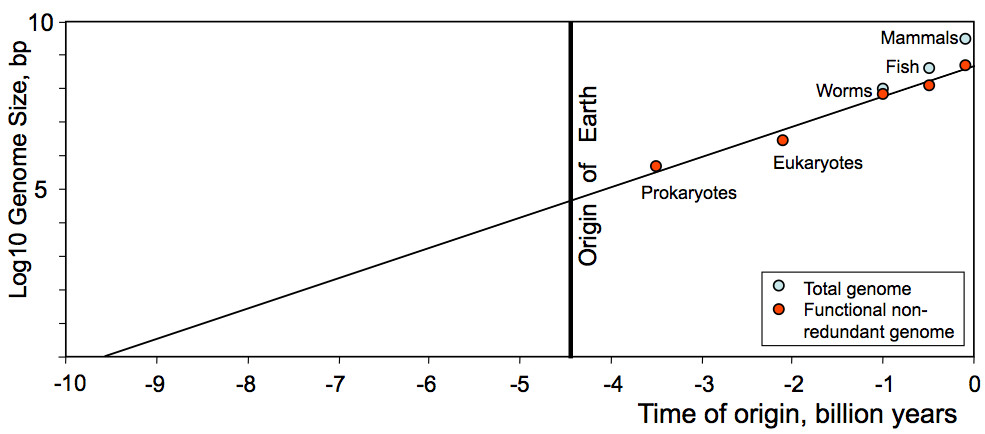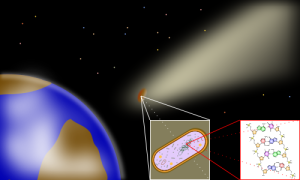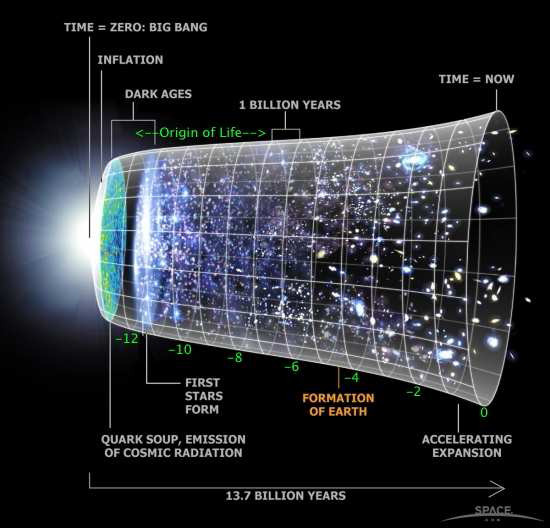Creation Corner
Life before Earth – or with it

Recently two scientists showed an amazing mathematical chimera: life before earth. They think they showed that life began 9.7 billion years ago – four billion years after the universe began. They really showed that life could not have come from non-life. At least, not on earth. In the process they made the creation story far more likely than they might care to admit.
Life before earth – the math
Alexei A. Sharov and Richard Gordon are geneticists. They work every day with genes. Genes are the firmware of life, as memory and experience are its software. One amoeba has enough information in its DNA to fill ten Libraries of Congress. So how did all that information write itself?
Jillian Scharr of Tech News Daily explains the Sharov and Gordon paper. (See the full text here.) Moore’s Law says the integrated circuits we used today, double their “gateways” every two years. If one projects this doubling back in time, one can calculate that microchips began in the 1960s. Which is historically true. Sharov and Gordon asked themselves: how if we apply Moore’s Law to DNA and backtrack that? They substituted DNA base pairs for the transistors (or what really replaces them) in modern integrated circuits. Base pairs are the letters of the DNA “alphabet,” as James D. Watson and Francis Crick discovered. This is how DNA holds the information to run a cell, and to build another.
Sharov and Gordon backtracked the development of DNA to one base pair. They calculated that life began with this one base pair – 9.7 billion years ago, give or take 2.5 billion.

Complexity of life (as billions of base pairs) over time. Graphic: Sharov and Gordon, “Life Before Earth.”
Life before earth – what that means
The consequences of this number should stagger the imagination. In calculating this spread of times for the origin of life, Sharov and Gordon made all the classic uniformitarian assumptions:
- Uniformity of law: natural laws hold everywhere and for all time.
- Uniformity of process: processes working today have always worked.
- Uniformity of rate: processes work at the same rate, or at least change only gradually.
- Uniformity of state: any change happens equally everywhere.
By those rules, they calculate that life could have begun shortly after the universe itself began. The matter in the universe (at least, what we can see) has a radius of 13.7 billion light years. So according to conventional theory, the universe began 13.7 years ago. Life could have begun, say Sharov and Gordon, any time from 7.2 to 12.2 billion years ago. Those same conventions say the earth itself is only 4.5 billion years old. Furthermore, life on earth began 3.8 billion years ago, again according to convention.
That’s why Sharov and Gordon named their paper “Life before Earth.”
[ezadsense midpost]
Sharov and Gordon admit several things that destroy many narratives that evolutionists cherish. First, again on conventional terms, life took 5 billion years to go from one base pair to a bacterium. Recall that Crick and Orgel, in 1973, proposed that a missile, laden with bacteria and blue-green algae, crashed on earth 3.8 years ago, and we are its by-product. (But Sharov and Gordon show that even that is impossible; more on that below.)
Second, if life came from non-life, that did not happen on earth. It can only have happened on another world.
Third: the directed panspermia of Crick and Orgel (see above) is impossible. The payload might have been as complex as earth would need. But who would build the missile? If life began even 12.2 billion years ago, no intelligent alien race would have time to evolve. So life before earth does not mean you can have extraterrestrial civilization. It means you can’t.

Artist’s conception of panspermia. Graphic: User Silver Spoon Sokpop/Wikimedia Commons, CC BY-SA 3.0 Unported License
Fourth: abiogenesis is impossible. The earth is not old enough! To Sharov and Gordon, life before earth is not only possible but necessary. So how did life get on earth? From outside, say Sharov and Gordon. That is, the life before earth model calls for panspermia, but not directed panspermia.
Fifth: Sharov and Gordon admit in effect that even the beginning of life before earth defied the Law of Averages. From their own abstract:
Experimental replication of the origin of life from scratch may have to emulate many cumulative rare events.
Or put another way: getting life from non-life would be like winning enough Power Ball jackpots, one after the other, to buy out every man, woman and child on earth.
Sixth: don’t expect an ET scout to land on earth, or to find ET civilizations if we head for the stars. They won’t be there. Frank Drake tried to guess how many civilizations might hear us (or give us a signal).
The equation is usually written:
N = R* • fp • ne • fl • fi • fc • L
Where,
N = The number of civilizations in The Milky Way Galaxy whose electromagnetic emissions are detectable.
R* =The rate of formation of stars suitable for the development of intelligent life.
fp = The fraction of those stars with planetary systems.
ne = The number of planets, per solar system, with an environment suitable for life.
fl = The fraction of suitable planets on which life actually appears.
fi = The fraction of life bearing planets on which intelligent life emerges.
fc = The fraction of civilizations that develop a technology that releases detectable signs of their existence into space.
L = The length of time such civilizations release detectable signals into space.
The problem: that equation assumes that after a good planet forms, life will begin on it. But Sharov and Gordon say life took 9.7 billion years (give or take 2.5 billion) just to go from one base pair to human beings. That life began on some long-dead world, then scattered through the galaxies on comets. So that equation needs a new term. Call it ps, or the probability that a seed comet would dive into a system and seed a planet. Then one must qualify the R* term. Why? Because the Drake equation assumes a steady state. But we don’t have a steady state. A comet that seeds a planet must do so at the proper time. That time must have been 3.8 billion years ago, the same as the origin of life on earth.
Charles Krauthammer once set forth the Fermi paradox: if ET civilizations are so common, why haven’t we heard a peep from them? He cited Carl Sagan, who suggested the earlier civilizations destroyed themselves. (Like, for example, the fabled Krel in the MGM motion picture project Forbidden Planet.) But Sharov and Gordon’s life before earth result says our civilization is simply the first, or only, civilization to emerge.
(As an aside, Sharov and Gordon reject out-of-hand the notion that any machine will arise to rule over, or replace, human beings.)
Life before earth – or life with earth
Much of this is still idle speculation. It assumes no intelligent agent for the guiding of life. Putting life before earth is a new approach to the problem. Sharov and Gordon are trying to model how life came to be as complex as it is today. They conclude life wouldn’t have time to become so complex if it truly began only 3.8 billion years ago, on earth. So they place life before earth, with comets to carry it to earth.
One must commend Sharov and Gordon for being more intellectually honest than most. They admit life could not begin on earth by conventional theory. And they explain that we are not likely to have to defend ourselves against alien invaders – because no such invaders have had time to develop.
But the Sharov-Gordon model has another problem. It depends on the Hubble Principle (mis-called the “Copernican Principle,” though Copernicus never said it and likely would never say it). It assumes every part of the universe – that is, the space itself – is the same age as every other part. Suppose it isn’t? Even conventional cosmology assumes the universe is expanding. Wouldn’t time dilation come with that expansion? If so, how could comets even reach the earth in time? It also assumes things about comets, and about radioactive materials, that Sharov and Gordon never considered. And those assumptions are not safe.
A model does exist for life beginning with the earth, and as complex as it would have to be at its beginning, to be as complex as we see it today. That model is the creation model. According to it, God set up the earth, set up its lands and seas, then planted the land, then spoke life into being in the sea, in the air, and finally on land.
[ezadsense leadout]
Terry A. Hurlbut has been a student of politics, philosophy, and science for more than 35 years. He is a graduate of Yale College and has served as a physician-level laboratory administrator in a 250-bed community hospital. He also is a serious student of the Bible, is conversant in its two primary original languages, and has followed the creation-science movement closely since 1993.
-

 Civilization3 days ago
Civilization3 days agoDC Pipe Bomb Arrest Raises Questions About Christopher’s Wray’s FBI
-

 Civilization4 days ago
Civilization4 days agoThe Legal Logic Behind U.S. Operations Against Narco-Terrorist Networks
-

 Executive4 days ago
Executive4 days agoNewsom’s ‘National Model’ for Homeless Wracked by Fraud
-

 Executive3 days ago
Executive3 days agoWhen You’re in a Hole, Stop Digging
-

 Education3 days ago
Education3 days agoWaste of the Day: Taxpayers Subsidize Football Coach Severance
-

 Executive2 days ago
Executive2 days agoWaste of the Day: Obamacare Failed Test, Approved Fraudulent Subsidies
-

 Civilization2 days ago
Civilization2 days agoPence Calls on Trump To Fire RFK Jr Over Abortion Drug
-

 Executive4 days ago
Executive4 days agoWaste of the Day: Feds Pay Nonprofits That Sue the Government
















Jeremiah Laments liked this on Facebook.
[…] Reprinted from Conservative News and Views […]
Seems like just more “scientific” guesswork so they can get their grant money!